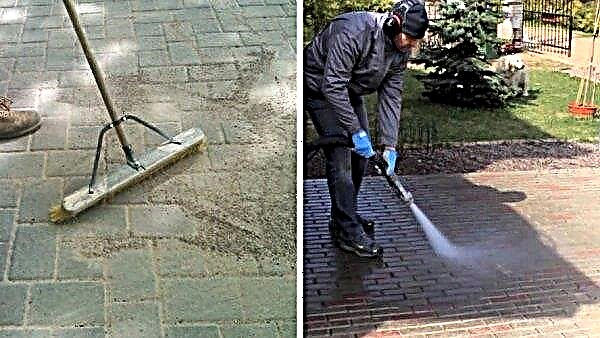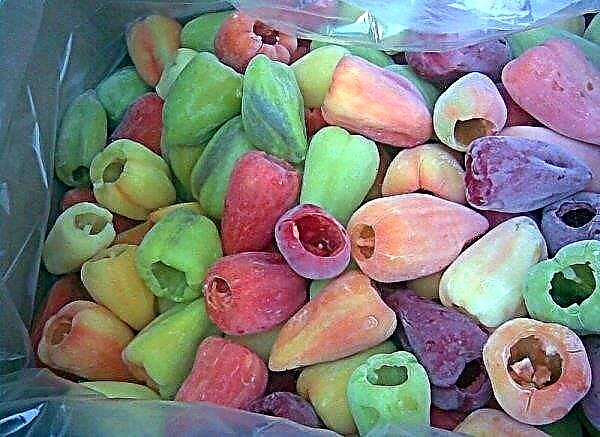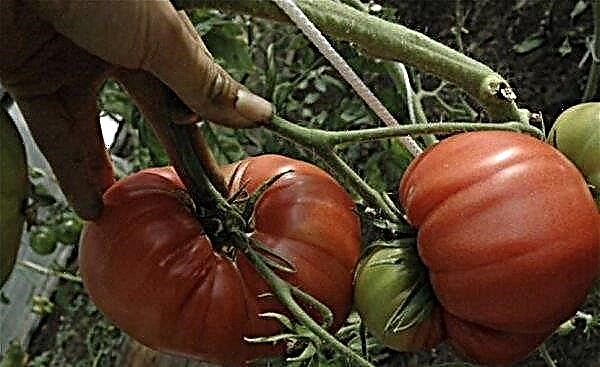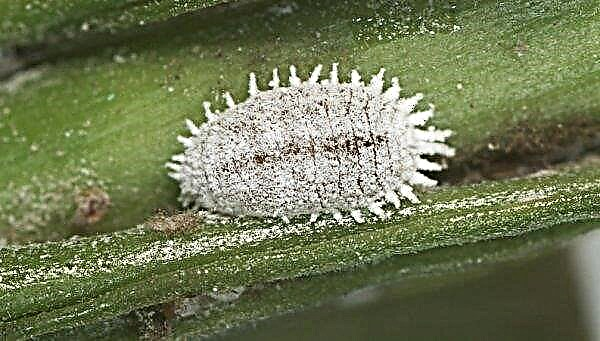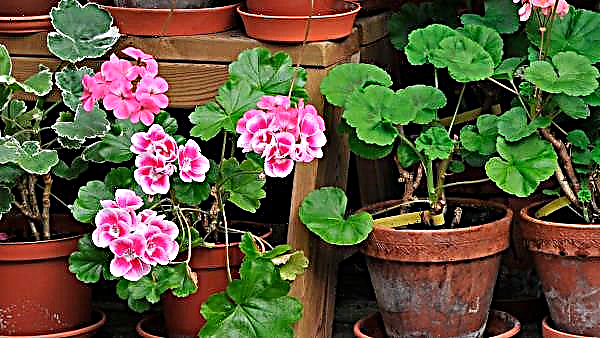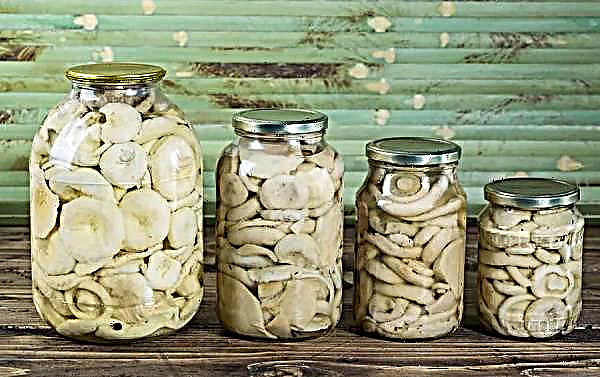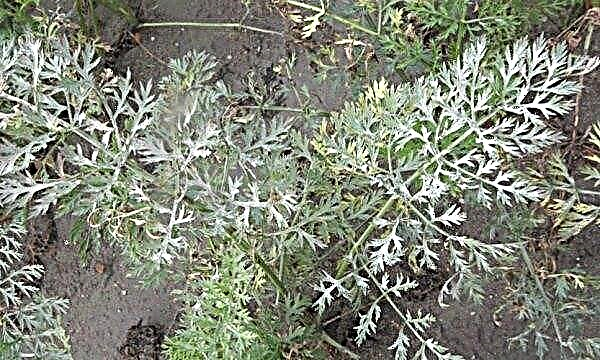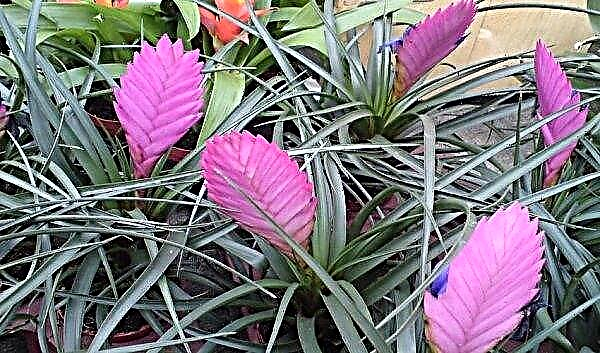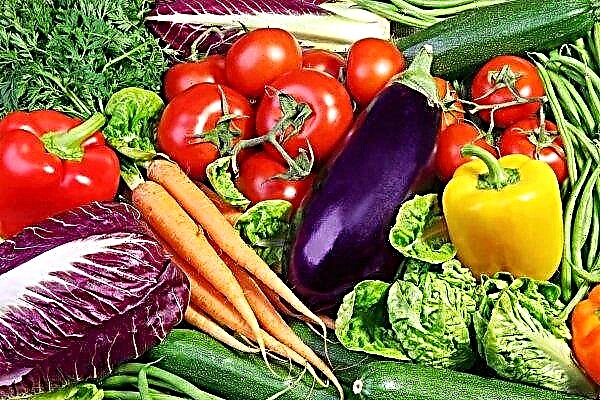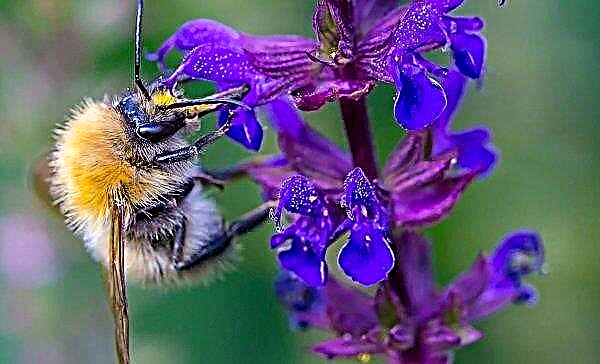Many gardeners are interested in early ripening varieties of tomatoes. One of them is "ultra-precocious." Read more about the yield of the variety and the features of cultivation.
Description and characteristics of the variety
The "ultra-early" was developed by breeders from Siberia. That is why it feels great throughout Eurasia. Its most characteristic features are:
- super-ripe variety: begins to bear fruit 70 days after the seeds have broken out of the ground;
- suitable for both growing in greenhouses and in open ground;
- standardized bush of determinant type: grows up to 55-70 cm in height;
- roundish fruits, weighing up to 100 g, usually bright red in color;
- one brush can contain up to 8 ovaries;
- the fruits have a dense pulp with a small number of seed nests, so they tolerate storage and transportation quite well;
- the peel is dense, shiny, the taste is sweet;
- has a high yield. With proper care, one bush brings about 2 kg of fruit, and with 1 square. m you can collect up to 13-14 kg of tomatoes;
- due to its high precocity, it is resistant to most diseases and pests.
Photo gallery
Pros and cons of the variety
- The advantages of the ultra-ripe variety include:
- rapid ripening of fruits almost simultaneously;
- unpretentiousness;
- developed immunity;
- tolerates short-term frosts, a sharp change in weather and low temperatures;
- whole fruits can be preserved.
- This variety has few drawbacks, but they are:
- the need to tie plants, since due to the abundance of fruits, untied stems can break;
- some difficulty of pinching.
Did you know? To protect young seedlings from night frost after planting in open ground, you need to conduct good watering between the rows at night. The temperature contrast between the warm soil heated by the daytime sun and the night cold causes fog to appear, which protects the bushes from frost.
Features of planting and growing
Almost all the rules for growing tomatoes of other varieties apply to "ultra-ripe" tomatoes, but there are some differences.
In the open ground
It is possible to grow "ultra-ripe" in the open ground with both seedlings and seeds. The south of Russia, almost the entire territory of Ukraine are quite suitable for growing without the use of greenhouses. This method, under favorable weather conditions, is applicable to most of Belarus and central Russia.
For this variety, the most preferred soil types are sandy or clay. If the acidity of the soil is high, in the fall, before digging, lime or chalk should be added to the soil.Important! When choosing a place for beds for future tomatoes, it should be remembered that this culture feels good after carrots, beets, onions, cabbage. They take root well after cucumbers, but after pepper, legumes and tomatoes, tomatoes grow poorly.
Shortly before digging the garden in the spring, future beds are treated with copper sulfate. From organics, it is worth using humus or compost (about 3 liters of humus per 1 bush). To grow seedlings, seeds are sown in late winter or early spring (it all depends on the specific climatic features of your climate zone). As a substrate, a special mixture is used, which can be bought in a store or prepared independently in this way:
To grow seedlings, seeds are sown in late winter or early spring (it all depends on the specific climatic features of your climate zone). As a substrate, a special mixture is used, which can be bought in a store or prepared independently in this way:
- Take peat, sand and turf in equal parts. Mix the mixture thoroughly and calcine in the oven for 20 minutes at a temperature of + 180 ° C- + 190 ° C (soil layer 4-6 cm). You can treat the substrate with boiling water with potassium permanganate (saturated color), and then again with simple boiling water.
- Pour dry mixture (slightly moist) into seedlings with drainage holes.
- Prepare a fertilizer of 0.5 tbsp. tablespoons of superphosphate, 1 teaspoon of potassium sulfate and 0.5 tbsp. tablespoons of urea dissolved in 5 liters of water.
- The resulting solution spill the soil mixture, wait until the excess liquid passes through the holes.
The box is covered with garden film, which is periodically removed. The soil should be constantly slightly moist. Watering the seedlings between the beds. If the soil is waterlogged, the film is removed for a while (until the earth reaches a normal degree of moisture), and the boxes are placed in a warm place. An indication that enough moisture is a slight evaporation on the inside of the film. Until the first shoot sprouts, you should carefully monitor the temperature regime (+ 23 ° C- + 25 ° C), but when the sprouts appear, you will need to take care of adequate lighting. A window sill without drafts is best suited.
Until the first shoot sprouts, you should carefully monitor the temperature regime (+ 23 ° C- + 25 ° C), but when the sprouts appear, you will need to take care of adequate lighting. A window sill without drafts is best suited.
When the seedlings rise to 2.5-3 cm, it must be dived. Choose the strongest shoot (if there are too many sprouts that have sprouted) and plant them in separate cups (preferably in peat).
After the shoots have grown stronger (by this time at least sometimes sunny spring days should fall out), they need to be hardened. To do this, on a suitable day, you must open the window or take out the seedlings on the balcony. To start, 5-7 minutes is enough, gradually increase the time. The main thing in the procedure is to avoid drafts.
By the time the seedlings reach the dimensions necessary for planting in the soil (seedling height - 25-30 cm, stem thickness - 5-6 mm), beds should already be prepared in the garden, which have already been treated with chalk or lime since autumn (this procedure reduces its acidity )Important! If the seedlings have already reached the condition necessary for planting in the ground, and weather conditions do not yet correspond to this, put it in a cool place and reduce the amount of watering - growth will slow down. After the plants get into favorable conditions, they will again confidently add in growth.
Weeds are removed, they are dug up and the following fertilizers applied:
- humus - 3.5 l / 1 sq. m;
- superphosphate - 1.5 tbsp. l / 1 sq. m
Spring procedures (after the soil has been dug up) is also such a process: future beds are poured with a solution of bird droppings (400-450 g / 1 sq. M), a solution of wood ash of the same concentration and a solution of ammonium sulfate (15-18 g / 1 sq. M). Select the concentration of the solution yourself. If the soil is sufficiently moistened, dissolve the fertilizer in a small amount of water. If you need good watering, you will need a solution of a lower concentration, but with a large volume of water.
The beds are preferably located from north to south. This arrangement contributes to better lighting. The distance between adjacent holes (as well as between rows) should be 45-50 cm. After the beds are marked and the holes are made, first treat everything with a strong solution of potassium permanganate in boiling water, and then with ordinary boiling water. It is recommended to plant seedlings on a slightly cloudy, calm day. Deepen the stem with the root system into the hole by 5-7 cm, then fill it with a substrate, slightly tamping. Plants should be watered with warm water.
It is recommended to plant seedlings on a slightly cloudy, calm day. Deepen the stem with the root system into the hole by 5-7 cm, then fill it with a substrate, slightly tamping. Plants should be watered with warm water.
Tomatoes of the "ultra-ripe" variety can be planted in seeds in open ground. They tolerate small spring frosts well. The advantage of this method: the plant becomes more resistant to frost, disease and pests.
As for the arrangement of beds, this procedure is no different from the above (for planting seedlings). But the seeds require more complex preparation.
Seeds before planting should be treated with “Immunocytophyte” (1/2 tablet per 500 ml of water) or nitrophos (1/4 hour for the same amount of water) as follows: thoroughly moisten a small terry towel with the resulting solution and spread the seeds over it. Twist the towel with a roller and place it in the refrigerator for 72 hours.Did you know? South American Indians cultivated tomatoes more than 2,800 years ago. They called the plant “a large berry”, which in the original sounded like “tomato”.
Then remove the roller from the refrigerator, soak it again with the solution, wrap it with cooking film (it will not allow moisture to evaporate) and keep it in the room for the same time.
Sowing seeds in the ground should be carried out (depending on the region) approximately in the second decade of May. Throw 3 sprouted seeds into prepared wells, add 1/2 tsp of urea and humus.
Video: Sowing tomato seeds in open ground
If it’s still cool (or you live in the northern part of Russia or Belarus), above each hole you can set a transparent plastic bottle upside down - a kind of mini-greenhouse. The space between the holes can be mulched or insulated with straw.
When the seedlings rise and get stronger, they are dived, leaving the strongest. The method of planting seeds in the ground is not very reliable. Due to the sharp freezing or lack of seeds, you can miss the planting time and be left without a crop.
The advantages of the method (viability, fruiting) have already been discussed above. So if the area of the plot allows, try both methods - then you will get the ultra-ripe tomato crop longer. First, bushes planted with seedlings will begin to bear fruit, and then - by the seed method.
In the greenhouse
To grow tomatoes in a greenhouse, you can apply the following scheme: do everything the same way as when growing seedlings until the time of diving, only in the process of diving, plant the shoots not in glasses (pots), but directly in the greenhouse.
Before planting seedlings, it is necessary to prepare the beds. It is advisable to do this 6-8 days before the planned date of disembarkation. Break the beds along the entire length of the room (the amount depends on the size of the greenhouse).Did you know? With proper cultivation of tomatoes in a greenhouse, you can get a crop 2.4 times larger than when grown on open ground.
Estimated size of beds:
- width - 60-85 cm;
- height - 35-45 cm;
- row spacing - 55-65 cm.
 After the introduction of fertilizers, the beds should be dug up, and before planting the seedlings, pour them with a solution of potassium permanganate (1 g per bucket of water, temperature — about 65 ° C).
After the introduction of fertilizers, the beds should be dug up, and before planting the seedlings, pour them with a solution of potassium permanganate (1 g per bucket of water, temperature — about 65 ° C).3-4 days before planting, remove the 3 lower leaves. This contributes to better aeration, reduces the likelihood of developing various diseases. When replanting seedlings in a greenhouse, you should remember some simple but important recommendations:
- the substrate should be warm (+ 13 ° C- + 16 ° C), garden film should be used to heat it;
- relative air humidity - not higher than 60-65%;
- the depth of the holes should not exceed 8 cm.
- you should not use a lot of nitrogen fertilizers, otherwise you will get a green garden with a minimum number of fruits;
- “Ultra-mature” is best planted in a checkerboard pattern, the distance between the holes is about 40 cm.
Tomato Care
To get a good tomato crop, it’s not enough just to plant high quality seedlings in the soil or greenhouse. Tomatoes, like any other culture, require some care. And although the "ultra-precocious" can not be called a whimsical variety, he still needs some care.
Important! You can not grow tomatoes and cucumbers in the same greenhouse. These most popular garden crops have completely different optimal temperature and humidity modes.
Fertilizer and watering
After 15-20 days after transplanting seedlings into the ground, the first top dressing should already be carried out. Experienced gardeners recommend using this solution (for 5 liters of water):
- nitrogen fertilizers - 12 g;
- phosphoric - 20 g;
- potash - 8 g.
Video: Topping Tomatoes
As for organics, you can use manure. In a bucket of water you need to dilute 1 liter of manure, after which leave the solution for 1.5-2 weeks. After this time, you will feel a characteristic smell, indicating the readiness of fertilizer. Take 1 liter of the resulting infusion and dilute it in a bucket of water. Use the product at the rate of 1 liter per 1 bush.
Tomatoes do not tolerate stagnation of water in the ground. This fact should be considered when watering plants. It is better to apply such an irrigation scheme. First: a large amount of water, but not too often. Second: in moderate heat, one watering every 3-4 days will be enough.Important! Remember that manure as a fertilizer for tomatoes should not be abused. The lack of minerals can be made up by adding the necessary fertilizers, but their excess is much more difficult to eliminate. A large amount of manure gives a lot of greenery, and few ovaries (and therefore fruits) are formed.
 Basic watering rules:
Basic watering rules:- avoid moisture on the green mass of the plant;
- better to water in the evening;
- if the street is cloudy, watering can be carried out during the day;
- apply rain or settled water with a temperature above + 20 ° С;
- drip type watering is most effective.
Shrub formation and pinching
All sinuses of the leaf after the first can give a new shoot (stepson) - a branch of the trunk on which fruits and ovaries will also form. As a result, the plant will be with a lot of green mass, but small fruits. To avoid this phenomenon, it is necessary to carry out stepsoning. This is the process of removing extra stepchildren.
Determinant varieties, which include the "ultra-mature", are harder to pinch for the reason that you can remove the shoot, which will continue to grow the bush. This stepson (main) completes the growth, at its end appears the final ovary. If it is removed, new shoots that give the ovary will no longer appear. The basic rules for planting tomatoes "ultra-ripe":
The basic rules for planting tomatoes "ultra-ripe":
- In order for the desired shoot to remain intact, stepsoning should be carried out no earlier than the stepson grows to 4 cm. Before the procedure, it is necessary to establish which shoot will become the main one. If in doubt whether to remove the shoot, it is better to leave it.
- Stepson preferably in the morning. They break off the escape with fingers (gloves should be used so as not to transmit any infection to the wounded plant). You can use a very sharp knife, only you need to act with the accuracy and determination of the surgeon.
- In the case of using a knife after processing one bush, the tool must be disinfected (potassium permanganate or bleach).
- The shoot is removed so that the stalk remains 1-1.5 cm.
- Cropped shoots are folded and removed from the beds to avoid the occurrence of diseases that they may cause.
Did you know? Currently, more than 9 thousand varieties and hybrids of tomatoes are known. The smallest tomato in diameter has a little more than 1.5 cm; the weight of the largest is more than 1400 g. The color of ripe tomatoes can be yellow, red and even black.
Soil loosening
Loosening the earth is best after watering. This will prevent the formation of a crust on the surface of the soil. Then weeds should be removed. Near the trunk you need to loosen very carefully so as not to damage the root system. The first three weeks the soil is loosened to a depth of 7 cm, and near the trunk - even less (3-4 cm).After the roots have grown, the depth of cultivation should be reduced.
Bushes should be earthed from time to time. The first time they wind up 3 weeks after planting on the beds, then - with the same frequency. This measure will not allow the roots to be exposed, prevent their overcooling, and will also contribute to the normal development of the root system.
Pollination
Tomatoes - a self-pollinated culture; they do not need pollinating insects, although they will not interfere. For guaranteed pollination, during flowering, you can gently shake the shoots with flowers 2-3 times a week. To attract insects, bright flowers are often planted nearby (for example, marigolds, calendula), which not only attract pollinators, but also repel parasites due to the substances contained in them.
Disease and pest resistance
Despite the fact that the variety is considered resistant to various kinds of diseases and pests that are usually attacked by tomatoes, spraying with infusion of shoots of garlic and wormwood can be used as preventive measures.
Some danger late blight. This happens in the case of sudden changes in temperature and humidity. To prevent this problem, plants are sprayed with Bordeaux fluid. As for pests, it is worth mentioning the bear and the whitefly. If, nevertheless, they chose tomatoes, then, as an effective means of struggle, the means Mospilan and Akellik proved themselves well.
As for pests, it is worth mentioning the bear and the whitefly. If, nevertheless, they chose tomatoes, then, as an effective means of struggle, the means Mospilan and Akellik proved themselves well.
To protect against wireworms, Bazudin is used: a mixture of the preparation and sand is made, which is placed in a small hole next to the tomato bushes where the wireworm has settled, and sprinkled with earth.
Cooking recommendations
A few words should be said about the culinary features of the variety:
- during the heat treatment, the peel of the tomatoes does not crack, so the variety is excellent for preserving the whole;
- good tomatoes of this variety and for fresh consumption, in salads;
- due to the dense pulp (due to the low water content, long evaporation is not required) they are an excellent raw material for making juices, sauces, ketchup, various canned food of home production (dressing for borsch, appetizers).
One can say about tomatoes of the “ultra-early ripening” variety that they quite deserved praise. But so that these tomatoes fully justify the name of the variety, they should be grown in greenhouses or seedlings.

